#Geometric Greek art
Explore tagged Tumblr posts
Text



An Attic Pottery Pyxis Geometric Period, 8th Century B.C.
#An Attic Pottery Pyxis#Geometric Period#8th Century B.C.#pottery#attic pottery#attic greek#ancient pottery#ancient artifacts#archeology#archeolgst#history#history news#ancient history#ancient culture#ancient civilizations#ancient greece#greek history#greek art#ancient art#art history
837 notes
·
View notes
Text
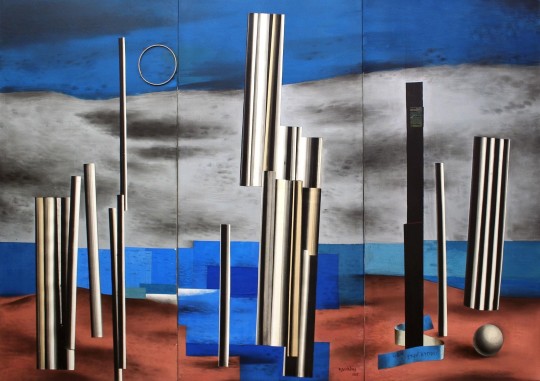
Kostas Iliadis (1903-1991) — Ode to Cyprus [marouflage and oil paint, on three canvases, 1985]
134 notes
·
View notes
Text

Greek Geometric Pottery Amphora
Origin: Mediterranean Circa: Geometric Period, c. 725-700 BC Dimensions: 18.75" Height x 10" Width (47.6cms x 25.4cms) Medium: Terracotta
#ancient art#ancient history#antiquities#ancient civilizations#greek mythology#greek pottery#greek geometric period#amphora#geometric art
50 notes
·
View notes
Text

A figure holding two tridents stands between horses. The scene has been interpreted as ritual horse-sacrifice, though this is not certain. Ancient Greek pottery fragment in the Geometric style, dating to the Archaic period (8th century BCE) and located in the Archaeological Museum of Argos. Photo credit: Zde/Wikimedia Commons.
#classics#tagamemnon#Ancient Greece#Archaic Greece#art#art history#ancient art#Greek art#Ancient Greek art#Archaic Greek art#Geometric period#pottery#potsherd#Greek religion#Ancient Greek religion#Hellenic polytheism#vase painting#Archaeological Museum of Argos
236 notes
·
View notes
Text


Got to work on these badboys yesterday!
#classical archaeology#greek vase#oinochoe#aryballos#olpos#classical antiquity#classical studies#classical philology#university life#university student#uni#dark academia#light academia#chaotic academia#literature#aesthetic#dark acadamia aesthetic#books#books and libraries#poetry#art#greek archaeology#greek art#ancient greece#geometric greece
31 notes
·
View notes
Note
I gotta research more about the mycaeans soon because its so so interesting!
If you'd be willing
Do you have some funfacts about them?
Or some comparisons (cultural, technological, artistic wise) between Homeric greece and mycaean greece?
If you want to ramble
Ohh yet another good one! Of course I am willing! What a question! Hehe Let's see what I remember as well from my times at studies! Hahahaha I love the ending though "If you want to rumble" Hahahahaha! As you see no problem with that dear! If it is rumble you want, rumble I shall deliver! Hahahahahaha!
Well unfortunately a great deal of information on the mycenaean greek society comes from some very good educated guesses based on the findings than anything else. Unfortunately even if Linear B, arguably the first known and confirmed form of archaic Greek, is valuable, we still do not have a large corpus or variety of texts. Most of the texts that are plenty even if fragmentary are mainly logistics from what we call "transactions with the palace or megaron" than actual sources of literature, laws or society and most of them were saved by luck. For ecample the extended corpus of Linear B plates found in the so-called "Nestor's Palace" in Pylos were saved only because the palace burnt, thus baking the raw clay and making the text readable nowadays. The texts however reveal valuable information on city names and goods being exchanged from one palace to another as well as names of people, official titles and gods' names! So we can tell one similarity we have is that in mycenaean times many of the gods known throughout the years of greek evolution were already known such as Zeus, Hera, Dionysus, Athena etc.
So religiously speaking they believed in the same pantheon (even if we do not have ALL the names of every god worshiped in later years the number of god names saved on the tablets can make us see that they have the same religion and culture on that part, although the worshipping practices are hard to pintpoint. The texts do mention that some offerings are made to the gods but the way they are done is subject of research. From the tablets we also know that the title of Priest and Priestess did exist so we are not, probably, speaking on a theocracy where the king is also an exlusive priest (although Homer seems to be touching the subject, making kings offer sacrifices, see for example Odysseus, and yet none of the kings also claim themselves a priest. In fact they get advised by priests)
For the political system we still make hypothesis on how it works. It seems like every major city has a region of influence around it and that transactions or taking care of the earth was regulated by the central palace or anactoron (thus the term anactorial system). It seems that the central palace was also the center of gathering goods from around the area for we have tablets that explicitly speak on transfers of goods from and to the palace outside. Of course the hypothesis that this is some sort of central palace being the residence of a king is purely hypothetical and based on the richness of its construction and its complexity rather than real evidence although the term "wanax" or "άναξ" aka "king" appears in the tablets but the hypothesis is very strong. We also see from examples such as Tyrinis a very strong connection with Anatolia and exchange of culture, for example we see the triangular arches

(image generated by me in one of my projects)
You can see examples here from Mycenae Hattusa and Tyrinis. The cultural and architectural exchanges reached their peak at about the middle of this period. Artistically speaking the Mycenaeans follow the traditions of the Minoans and we see exceptional artworks happening. For example we follow the tradition of siglia rings engraved in stone and gold and if I may some of them are of exceptional beauty for example the ring at the tomb of "Griffin's Warrior" in Pylos that dates exactly to the passage between the one civilization and the other.

In art we also see very beautiful war or hunting themes in pottery art or even in weaponry. Some researchers compared it to Minoan times and claimed that it is "less sophisticated" but quite honest some of the samples are also very well preserved even if more simple to their execution
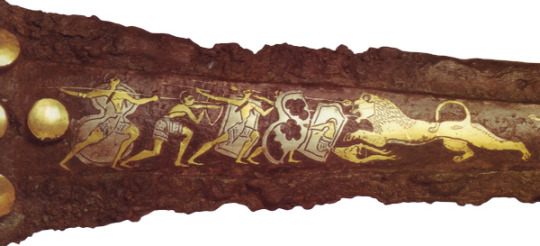

Technologically I think the Mycenaeans were far more advanced than what people give them credit for. For example greeks are always known for their hydraulic "machines" among others but how many people know really that they managed to drain the entire lake Kopais, around the fortification of Gla like 3000 years ago? The Greeks took advantage of undergdound tunnels that naturally existed and managed to make the water escape thus creating grounds for growing crops. Kopais lake was at some point re-filled with water and in modern days people tried to re-drain it without a result and they discovered the mycenaean draining system which was still functional and to this day the lake Kopais remains drained and used for growing crops
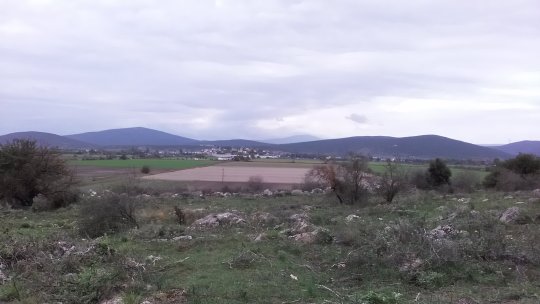
(photo taken by me a few years ago)
For some reason at the end of bronze age internal conflicts, outside attacks as well as the Doric Greek Tribes coming from the north, created a hostile environment which led possibly to wars and conflict that eventually is estimated to have led to the fall of Palatal system. We do see for example the existence of fortifications such as Gla in the middle of nowhere which probably served as refuge for those who were getting attacked and for better supervision of the area.
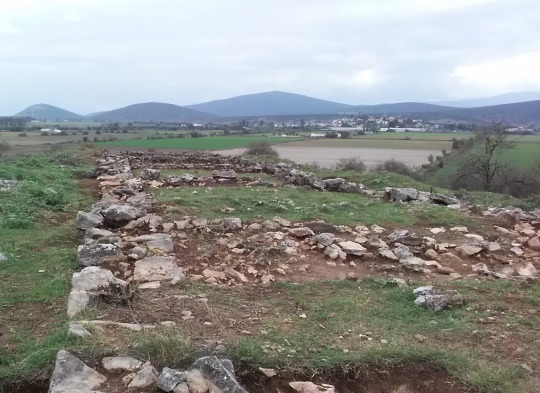
(photo taken by me in the same location)
This eventually led to the beginning of the Iron Age and Homer's era with the rise of City State eventually at the Archaic Years. I believe we can talk on a small change to the situation in Homer's time although the City State form of government doesn't seem crystalized at his time we do see some of it in his epics so maybe we can talk on this change on the political spectrum with also the stopping of existence of palatial system and starting to shift to other forms of government (eventually to the upcoming centuries the kingdoms will almost cease to exist with some exceptions such as the kingdoms at upper Thessaly, Macedonia, Epirus and Sicily. Sparta is also an exception for they keep their kings but the main power is held by the elders)
We do not have much evidence on Homer's time either given how little written evidence is being saved. But we do get the shift in written language from Linear B to the Greek alphabet (adapted from the Phoenician one) which is the Alphabet we use to this day. One of the most ancient samples of it is the so-called "Nestor's Cup" which dates in the 8th century BC and includes one of the first samples of Greek Alphabetical scripture. Technologically speaking of course we have the extensive use of Iron and steel that wasn't a thing before as much and potentially we have more the use of tools for geometric shapes.
Artistically speaking we have samples of little statuettes and vases that mostly depict geometric shapes (thus giving the name to the period as "Geometric Period". We have also some of the early samples of chariot depictions in this geometric style and in fact I have heard some researchers associate this art with a narrative, potentiall even quoting the homeric poems that possibly gained popularity such as this famous sample):
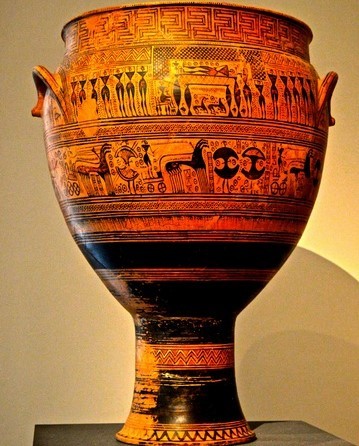
Another thing that needs to be said is that at the 8th century BC we also have the beginning of an event we follow to this day, the Olympic Games which according to the scriptures that we have is placed to 776 BC
I believe this is a very crude separation but if there is more you would like to know I would be happy to respond!
#greek mythology#tagamemnon#katerinaaqu answers#homeric times#mycenaean#ancient greece#geometric greece#iron age greece#bronze age greece#ancient greek poetry#ancient greek art#ancient greek history
33 notes
·
View notes
Text

Apollo series # 1(1969) by Theo Hios (1908-1999)
#greek#art#art history#τέχνη#ζωγράφος#painting#painter#contemporary art#geometric art#abstract art#abstraction#Apollo#Theo Hios#greek american
9 notes
·
View notes
Text
Kaidan: *walking at the head of the group, watching Aurorwren fly overhead* hm? Oh fock, bandits up ahead.
Inigo: how many?
Kaidan: enough to be a prob-
*Terrified agonised screaming echoing from an unseen source*
The bandits: *all look around in a panic before running off and hiding*
Aurorwren: *lands putting his death whistle away* they shouldn’t be a problem now.
Lucien: I???? What? How did you do-
Kaidan: you were the one screaming?! Are you hurt?!
Aurorwren: what? No *pulls the whistle back out* it’s an Ayleid death whistle. They were used in battle to frighten our enemies but were mainly implemented by slavers to terrify the nedes. Mine came in good use when Morihaus needed to get through the main gates of what’s now the imperial city, so I cleared a path for him by scaring my own kin out of the way. You blow into it and it sounds like someone screaming in pain.
Kaidan: I- that is. Terrifying.
#inspired by Aztec death whistles#Ayleids for me are a mix of Greek Roman and Aztec in design#a lot of geometric patterns in their art fashion and so forth#being referred to as feathered also reminded me of traditional Aztec garb#plus death whistles are really interesting to me lol#Aurorwren dragonborn#ayleid dragonborn#Kaidan skyrim#inigo skyrim#Lucien skyrim
33 notes
·
View notes
Photo

#northroadtattoo #brighton #statue #greek #roman #classical #time #ancient #tattoos #geometric #tattoo #tattooart #art #bn1 #northlaine #tattooist #northlaines #tattooer #brightontattooshop #brightontattooartists #brightontattoostudio #tattooideas #tattoostyle #tattoolife @rapidotat2 @north_road_tattoo_brighton (at North Road Tattoo) https://www.instagram.com/p/CocWRyDouNk/?igshid=NGJjMDIxMWI=
#northroadtattoo#brighton#statue#greek#roman#classical#time#ancient#tattoos#geometric#tattoo#tattooart#art#bn1#northlaine#tattooist#northlaines#tattooer#brightontattooshop#brightontattooartists#brightontattoostudio#tattooideas#tattoostyle#tattoolife
2 notes
·
View notes
Photo

""Epic quest for winning and soul..."" by passqs on INPRNT
#art#print#illustration#artist#passqs#night#geometric#pattern#digital art#moon#greek#dream#building#lines#archichture#encient#inprnt
1 note
·
View note
Photo

Mycenaean Art
The Mycenaean civilization flourished in the late Bronze Age from the 15th to the 13th century BCE, and their artists would continue the traditions passed on to them from Minoan Crete. Pottery, frescoes, and goldwork skillfully depicted scenes from nature, religion, hunting, and war. Developing new forms and styles, Mycenaean Art would prove to be more ambitious in scale and range of materials than Cretan art and, with its progression towards more and more abstract imagery, go on to influence later Greek art in the Archaic and Classical periods.
Inspirations
The Mycenaean civilization was based on mainland Greece but ideas and materials came via trading contacts with other cultures across the Mediterranean. Imported materials included gold, ivory (principally from the Syrian elephant), copper, and glass, while in the other direction went Mycenaean goods such as pottery to places as far afield as Egypt, Mesopotamia, the Levant, Anatolia, Sicily, and Cyprus.
In art as expressed in fresco, pottery, and jewellery, the earlier Minoan culture on Crete greatly influenced Mycenaean art. The Minoan love of natural forms and flowing design especially was adopted by Mycenaean artisans but with a tendency to more schematic and less life-like representation. This new style would become the dominant one throughout the Mediterranean. Geometric designs were popular, too, as were decorative motifs such as spirals and rosettes. Pottery shapes are much like the Minoan with the notable additions of the goblet and the alabastron (squat jar) with a definite preference for large jars. Terracotta figurines of animals and especially standing female figures were popular, as were small sculptures in ivory, carved stone vessels, and intricate gold jewellery. Frescoes depicted plants, griffins, lions, bull-leaping, battle scenes, warriors, chariots, figure-of-eight shields, and boar hunts, a particularly popular Mycenaean activity.
Continue reading...
99 notes
·
View notes
Text
Lunari Heritage in Zaun
This is gonna be a reach, but from the little we've seen of Vi and Jinx's mom and younger Silco, I'd guess they were both from the same ethnic group.
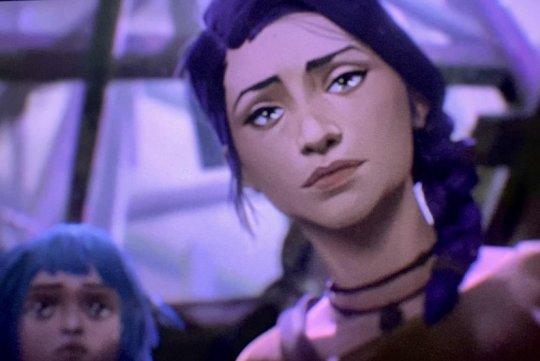

In a place like Zaun, where the people are left with scraps, any piece of jewelry sticks out. Vi's mom and Silco are both wearing similar pieces of jewelry. Silco's bracelet could likely be fitted as a necklace since it twice wraps over his wrist. Neither are wearing anything of high quality, but the necklace and bracelet in their respective pictures seem decently maintained if not worn. That's when I thought, these are probably heirlooms.

In fact they looked pretty similar too, but in smaller scale of the princess's own pendants. I wouldn't bring this up if it weren't for the fact that Piltovans prioritize elaborate art-deco aesthetics, the more elaborately geometric the better (Councilor Shoola). So you would assume even the simplest jewelry would be a square pendant or a straight line. But no, big plain circles, and then I remembered we saw that before, on the princess Ambessa killed. Big bronze circles.

And when we look at young Vi , you notice that she's wearing jewelry too. A simple necklace with a green (it looks green) gem. And I realized that the princess's necklace was also adorned green gems.

I'm pulling from scraps, but it's interesting that small things these Zaunites have to adorn themselves (though not for long with the time skips) are similar versions if not simpler version's of the princess's.

At first I thought this meant that many of the cast were actually of Ionian descent. But then in the Princess's scene a thought kept coming back to me, "Why is Mel wearing purple?". Mel, a skilled diplomat from a young age, typically wears the main colors of the nations she hosts and is hosted by. White for Piltover, Black for Noxus (Ambessa), and always with her signature accents of gold. So if Mel followed her mother to Ionia ,where green is a culturally significant color, why purple? It's because Mel and Ambessa weren't in Ionia, they were in Targon fighting the Lunari.
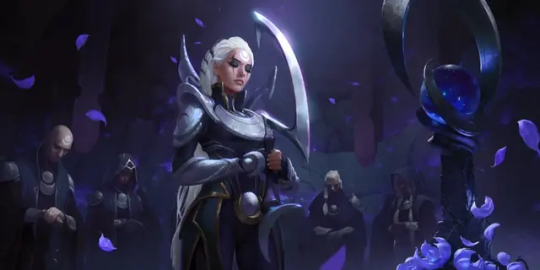

The Lunari are Rakkor tribal people in the Targonian region who worship the moon, and are persecuted for it by the Solari, the religious order that worships the sun. While technically Mt. Targon is influenced by Mt. Olympus and Greek mythology aesthetic, that's more the case for the Solari. Overtime the Lunari aesthetic has been mixed it's originally nomadic culture with East Asian influences. The prominent colors of the Lunari happen to be turquoise, silver, black and purple. It was such a little thing to remember but it made me see connections I hadn't thought about.
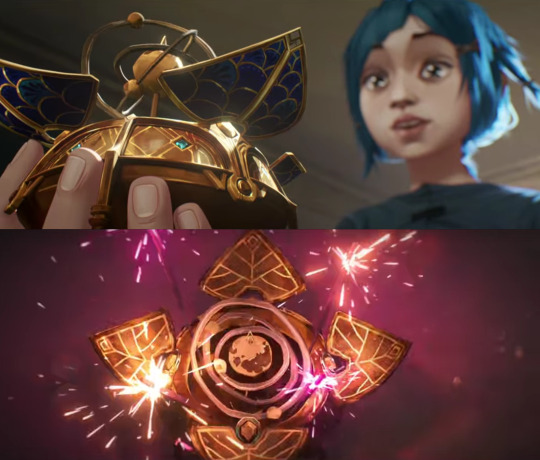
Suddenly everything starts to connect. The bronze coins represent the 3 moons that exist in Arcane's Runeterra. How do we know there are 3 moons, because the Valdiani piece Jinx stole was depicting their planet. In the Valdiani there are 3 orbits circling the Earth, meaning 3 moons (or satelites). Now the engraving on the gold of the princess's necklace makes sense, because it's supposed to resemble the gates at the peak of Mt. Targon. The pendant itself is shaped like the mountain with the gates fitted at the top.


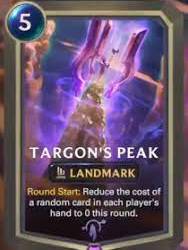
Frankly, it works for the Princess to have been Lunari and waves of descendants of the Lunari to arrive in Piltover and end up in Zaun. In Arcane, Piltover was created as a safe haven to escape the Rune Wars 200 years from the start of the show. Even after the Rune Wars ended the shipping port has likely seen waves of migrant labor and refugees from the ongoing crisis that occur in Runeterra (*cough*Noxus*cough*). It's likely that many of the current generation of Zaunites are of mixed heritage of the various fleeing people's.
It creates a whole new dynamic of the ways in which Piltover's laws, their Ethos, strips the people of Zaun from their identity and reducing them to tools for the mines. Magic is inherently a part of religious ceremonies and religion in general in Runeterra, especially for the Lunari. How do you practice your religion in a place that has banned the means by which it's conducted? There must have been more people like the Lunari who didn't have a problem with their magic, their problem was that they were being persecuted.
The remnants of family keepsakes brought over as communities fled were clung to as best as possible especially as they had to let go of part their spiritual identity. But even that doesn't seem to have lasted either. Vi doesn't keep her necklace, her mother is dead, so lost is her necklace, and we never see Silco wear his bracelet. They could have been stolen, or at best, hidden for safe keeping, maybe Enforcers get suspicious at the hint of mysticism and suddenly they want to talk.
Finally, maybe a little less related, it is interesting how prominent Piltovans and Zaunites take on day and night aspects. The sun shines over Piltover at their best, begins to set at times of uncertainty. While in the cover of night with moon above, the strongest Zaunites strike hardest. One more thing, it is interesting how Arcane's Jinx has taken on darker tones of purple rather than stick with neon pink. I always have to go back and look at a reference to remember that her pants are purple-er than I recall.
Update: I wanted to include that the large doodle Jinx made on her cup actually looks similar to the Lunari's sigil. And the sigil remains on the cup into the timeskip, also the center moon is made smaller within the crescent like in the necklace. I also noticed Jinx's cup later has more violent bomb imagery around it.
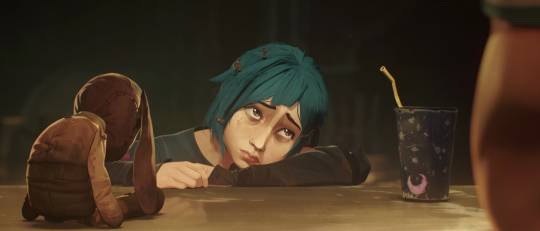


Update 2: With the final season approaching I'm noticing this is getting some attention again. I would like to say that if I could write this from scratch again I'd say it's more likely the princess is from Ionia now, which doesn't up end the Lunari theory.
Previous League canon confirms the Lunari faith does have ties to Ionia. A good portion of the Lunari are Ionian in descent, and Diana, their aspect of the moon (essentially their demigod), currently lives in Ionia. League even created skinline for Ionians blood moon worshippers, an edgy offshoot of the Lunari faith. It's all very interesting and a bit complicated because Riot loves to drop plot points in the lore and never come back. I'll try to clean something up for a longer explanation later. What's crazy is the Medardas are still the aggressors because Noxians and Solarians, which the Medardas are both, terrorize Ionians and Lunaris respectively.
#arcane#lunari#zaun#silco#vi arcane#jinx arcane#mel medarda#there's a lot to think about#for everyone including mel#piltover#arcane theory#arcane meta#arcane speculation#thank goodness i wrote this before i discovered the blood moon aspect or i would have writtern something WAY longer
988 notes
·
View notes
Text
Vedic Astrology - Future Spouse Prediction:
Name Meaning part 2

In the 1st part of this series (which I will link below) I explained how you can check for the planet that is ruling the Nakshatra in which your 7th house lord in the D1 chart is placed in and how that planet and the next chaining Nakshatra lord planet can give you clues about the theme of you spouses name meaning. To demonstrate how this technique works I have taken Brad Pitt as an example in part 1 and have given you themes of Sun and Ketu. In this part I will give you some more celebrity examples and the themes of the other planets.
Justin Bieber
He has Taurus in the 7th house in his D1 chart, therefore it is ruled by Venus, so we look in which Nakshatra Venus is placed in. His 7th lord Venus is placed in Purva Bhadrapada Nakshatra which is ruled by Jupiter. Jupiter is the 1st planet we take note of. Next we look again in which Nakshatra Jupiter is placed in. His Jupiter is placed in Vishakha Nakshatra which is also ruled by Jupiter. So what this tells us is that the meaning of his spouse's names will revolve around the themes of Jupiter. Now let's look at the themes of Jupiter.
Jupiter: anything related to wisdom/spirituality, learning/teaching, philosophical/mythological tales/stories, various deities, nature/outdoors/wilderness, travel, adventure, optimism/boldness, luck, abundance/expansion, morality and many more...
If we look at the meanings behind the names of Hailey Bieber's full name before she was married, we can see the themes of Jupiter playing out.
Hailey Rhode Baldwin
Hailey in Irish means wise one
Rhode has various meanings which fall under various Jupiterian themes. One of them is clearing in the woods (nature themed). The other meaning is where roses grow (also nature themed). The other one is the Greek island Rhodes which has a Greek mythological story behind its name.
Baldwin means a bold and brave friend (boldness themed)
As we can see all three of her names fall under the Jupiter archetype.
More example: this time predictive ones
Jungkook
He has Gemini in the 7th house in his D1 chart, therefore the 7th lord is Mercury and we look at the Nakshatra where his Mercury is placed in. His 7th lord Mercury is in Purva Phalguni Nakshatra which is ruled by Venus. We take note of Venus as the 1st planet and look further in which Nakshatra his Venus is placed in. Venus is placed in Chitra Nakshatra which is ruled by Mars and we take Mars as his 2nd chaining Nakshatra planet. Now we look at the themes of these two planets.
Venus: anything related to love, beauty, aesthetics, feminity, romance, desire, pleasures, elegance, flowers, music, poetry, art, wealth, justice/fairness, balance and many more...
Mars: anything related to war (fighting/soldier/weapons/conquering/land/fire), anger, passion/motivation/aspiration, masculinity, strength, speed, support/protection, hero/savior, and many more...
The meanings of his future spouse's first, (middle) and last name could revolve around the themes of these two planets Venus and Mars.
Bangchan
He has Scorpio in the 7th house in his D1 chart, therefore the 7th lord is Mars and we look at the Nakshatra in which his Mars is placed in. His 7th lord Mars is in Anuradha Nakshatra which is ruled by Saturn. We take note of Saturn as the 1st planet and look further in which Nakshatra Saturn is placed in. His Saturn is placed in Revati Nakshatra which is ruled by Mercury, we take note of Mercury as the 2nd chaining Nakshatra planet. Now we look at the themes of these two planets.
Saturn: anything related to time, nostalgia, discipline, life lessons, karma, maturity, struggles/hardships, serving/servant, work/careers, limitations/restrictions/rules/laws, ink, metals (but gold and silver are mostly ruled by Sun and Moon still), icyness, stone, firmness and many more...
Mercury: anything related to words/numbers, speaking/writing, intellect/cleverness, colors/vibrancy/creativity, geometrical forms/shapes, petiteness/youthfulness, children, joyfulness, a message/information, skills/crafts and many more...
The meanings of his future spouse's first, (middle) and last name could revolve around the themes of these two planets Saturn and Mercury.
Mingyu
He has Sagittarius in the 7th house in his D1 chart, therefore the 7th lord is Jupiter and we look at the Nakshatra in which his Jupiter is placed in. His 7th lord Jupiter is in Shravana Nakshatra which is ruled by Moon. We take note of Moon as the 1st planet and look further in which Nakshatra Moon is placed in. His Moon is placed in Purva Bhadrapada Nakshatra which is ruled by Jupiter, we take note of Jupiter as the 2nd chaining Nakshatra planet. Now we look at the themes of Moon, because we already discussed Jupiter before.
Moon: anything related to the moon itself, emotions/feelings, water, purity, sparkling, night, dreams, wishes, intuition, healing, sensuality, nourishment/care, home/mother, motherliness, calmness and many more...
And Jupiter (see themes mentioned above)
The meanings of his future spouse's first, (middle) and last name could revolve around the themes of these two planets Moon and Jupiter.
Other planet's themes
Rahu: anything related to exoticness/foreigness, the sky, clouds/fog/smoke/shadow, heights, illusions, uniqueness/unconventionality, rebelliousness, taboo, fame, mystery and many more...
Also as for names with cardinal directions in their meanings:
Sun is East. Mars is South. Venus is West. Jupiter is North.
🌺🌺🌺🌺🌺🌺🌺🌺🌺🌺🌺🌺🌺🌺🌺🌺🌺🌺🌺🌺🌺🌺🌺🌺🌺🌺🌺🌺🌺🌺🌺🌺🌺🌺🌺🌺🌺🌺🌺🌺🌺🌺🌺🌺
With that I have covered all the planets and their themes. Of course there is so much more to say for each planet but these are the ones in the overall frame so you can get an idea of what the names could be like. I hope this was informative and well explained.
Thanks for reading. See you soon.🌺
#sidereal astrology#astro observations#vedic astrology#astro notes#future spouse#sidereal chart#vedic astro notes#sidereal#vedic astro observations#navamsa#darakaraka
115 notes
·
View notes
Text

Ancient Pottery from the Italo-Geometric period, Cypro-Geometric, and Attic.
#ancient art#ancient history#antiquities#ancient civilizations#greek mythology#antiquity#ancient cultures#greek pottery#geometric period#attic vase
11 notes
·
View notes
Text




Posting my portrait series now! I honestly had fun doing this last year (˵ •̀ ᴗ - ˵ ) I only did the first years, second years and the vice dorm leaders as I made a separate model sheet for the dorm leaders (which I’ll be posting soon!)
Some headcanons and design notes under cut!
- I was inspired by Lili’s (aka koutingmiao/zvevdacito) design of the first years based on her own headcanons so I used some of her art as a reference in drawing Sebek, Epel, and Jack.
- I really wanted to show the stylization of everyone’s eyes in my rendition for the first years! Ace’s eyes are more so based off Tanjiro’s eyes (KNY) while Deuce has spade shaped pupils. Epel’s are more sparkly and wide to really show his “cute” side, Ortho’s eyes are similar to camera lenses or targets, while Jack and Sebek’s are more geometrical.
- As for their facial features, it’s more based on my ethnicity headcanons for them! Ace is Filipino-English, Deuce is Korean, Jack is Carribbean (Jamaican specifically), Epel is Norweigan, Sebek is Chinese-Welsh, and Ortho is Greek-Russian!
#₍ᐢ. ̫ .ᐢ₎ ; pddngart#twisted wonderland#twst#twisted wonderland fanart#twst fanart#twisted wonderland headcanons#twst headcanons#twst hcs#ace trappola#deuce spade#jack howl#sebek zigvolt#epel felmier#ortho shroud#traditional art#scanned atleast#im still wondering if i should redraw them;; havent drawn them in a while
75 notes
·
View notes
Text
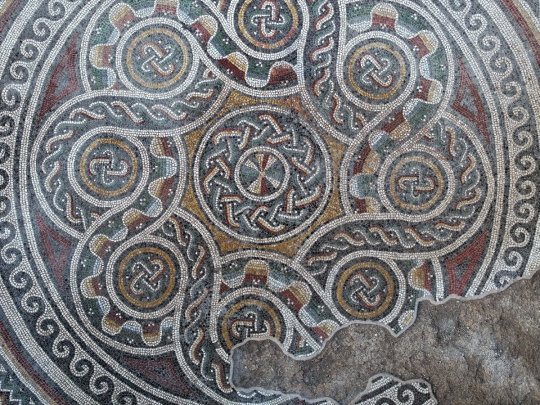
The Largest Ancient Floor Mosaic in Turkey Uncovered
The structure with the largest floor mosaic in Cappadocia and Central Anatolia Region was unearthed during the excavations carried out in Örenşehir District of İncesu district of Kayseri province, located in the center of Türkiye.
During ongoing excavations, new mosaics were unearthed from the villa, which is estimated to have been built in the 4th century.
The excavations are carried out under the direction of Nevşehir Hacı Bektaş Veli University, Department of Art History, Lecturer Dr Can Erpek.
Kayseri Provincial Director of Culture and Tourism, Şükrü Dursun, stated that the excavation began three years ago and that “the structure is expanding every year.” The initial assessment of the mosaic area, which was 300 square meters, has now reached up to 600 square meters.”

Stating that the excavations carried out with the support of Kayseri Metropolitan Municipality continued in an area of approximately 4 thousand square meters, Dursun continued his words as follows:
“In our assessments, we have come to the conclusion that this place was built in the 4th century. According to the findings, there are also traces dating back to the 3rd century and beyond. The quality craftsmanship used in the floor mosaics suggests that this place was used as a very important villa in its era.”
“In the area identified as the reception hall, a Latin inscription was found. In addition to that, Greek inscriptions were also uncovered. Geometrically decorated mosaics are predominantly present here. We have reached the end of our excavations for this year. Hopefully, our work will continue next year.”

The excavation director, Can Erpek stated that the structure continued to be used during the Byzantine period and after the Turks came to Anatolia.
He said, “This place has approximately 33 rooms, spread over a very large area, and is a high-level residence. We have not yet fully reached the boundaries of this residence. It has highly valuable floor mosaics. In the Central Anatolia Region, which includes the Cappadocia region, we do not see such a large residence with floor mosaics. In Cappadocia, during the Roman and Byzantine periods, we generally know about imperial properties. Here, we have encountered the name ‘Hyacinthos’ in the inscriptions. We consider this name to belong to an administrator. When the data becomes clearer, we can more confidently say that it was the residence of an important figure serving in imperial property.”

Stating that Kayseri resembles an open-air museum, Metropolitan Mayor Memduh Büyükkılıç stated that they supported 6 archaeological excavations in different parts of the city.
Büyükkılıç said, “The mosaics unearthed during the excavations here once again emphasized that Kayseri is the cradle of civilization in Anatolia,”.
By Oguz Kayra.
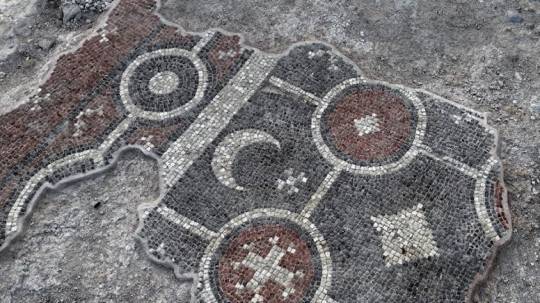


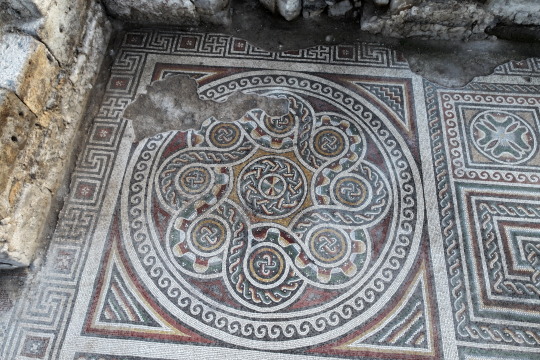

#The Largest Ancient Floor Mosaic in Turkey Uncovered#Cappadocia#Central Anatolia Region#mosaic#art#artist#art work#art world#art news#ancient artifacts#archeology#archeolgst#history#history news#ancient history#ancient culture#ancient civilizations#roman history#roman empire#roman art
226 notes
·
View notes